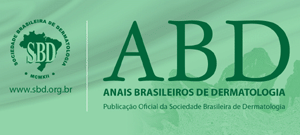Resumo em Português:
FUNDAMENTOS: A síndrome de Sweet corresponde a um conjunto de alterações cutâneas, sistêmicas e histopatológicas como resposta a diversos estímulos, semelhantes ao eritema nodoso, ao eritema multiforme e à vasculite leucocitoclásica. São descritas condições associadas como infecção, gravidez, uso de drogas e malignidades. OBJETIVOS: Avaliar as alterações clínicas e histopatológicas da síndrome, relacionando-a a outras condições. MÉTODO: Estudo retrospectivo de 73 casos com avaliação microscópica de lesões cutâneas, dados clínicos e laboratoriais. RESULTADOS: Houve predomínio de mulheres (83,0%), brancas (49,2%), entre a quarta e a sexta décadas de vida (73,8%). Placas eritematosas (76,9%), pápulas (43,0%), pseudovesiculação (PV) (38,4%) e lesões em alvo (18,5%) foram as principais alterações. Entre as condições associadas, infecções de vias aéreas (15,4%) e uso de drogas (10,8%) foram as mais frequentes. Outras associações, representadas por um caso cada, foram: linfoma de Hodgkin, gravidez, colite ulcerativa, policitemia vera e lúpus eritematoso em paciente com Aids. Neutrófilos com leucocitoclasia (98,6%), degeneração do colágeno (87,7%), edema (74,0%) e PV (38,4%) foram os principais achados microscópicos. Eosinófilos estiveram presentes (41,1%) de raros a abundantes e, em geral, não relacionados ao uso de drogas. O infiltrado inflamatório atingiu a derme profunda em 47,9% das vezes e encontrou-se paniculite em 80,0% dos casos nos quais a hipoderme estava representada (10 casos). CONCLUSÕES: Os achados, de modo geral, coincidem com os da literatura, destacando-se: frequente participação de eosinófilos sem correlação com a ingestão de medicamentos, paniculite e rara associação com linfoma de Hodgkin, sendo este o quinto relato de tal ocorrência, segundo o conhecimento dos autores.
Resumo em Inglês:
BACKGROUND: Sweet's syndrome refers to a set of cutaneous, systemic and histopathological alterations that occur in response to different stimuli, in a similar way to that occurring in erythema nodosum, erythema multiforme and leukocytoclastic vasculitis. The syndrome has been described in association with conditions such as infections, pregnancy, the use of certain medications and malignancy. OBJECTIVES: To evaluate the clinical and histopathological alterations occurring in this syndrome and to assess the association between these alterations and other conditions. METHODS: A retrospective study of 73 cases was conducted, evaluating data on the microscopic examination of skin lesions, as well as clinical and laboratory data. RESULTS: The majority of the patients were female (83.0%), white (49.2%) and between 30 and 60 years of age (73.8%). The principal alterations found were: erythymatous plaques (76.9%), papules (43.0%), pseudo-vesiculation (PV) (38.4%) and target lesions (18.5%). With respect to the associated conditions, upper respiratory tract infections (15.4%) and the use of medication (10.8%) were the most common. Other associations, albeit represented by only one case each, were: Hodgkin's lymphoma, pregnancy, ulcerative colitis, polycythemia vera and lupus erythematosus in a patient with acquired immune deficiency syndrome (AIDS). The principal microscopic findings were: neutrophils with leukocytoclasia (98.6%), collagen degeneration (87.7%), edema (74.0%) and PV (38.4%). The presence of eosinophils (41.1%) ranged from rare to abundant and was usually unrelated to the use of medication. Inflammatory infiltrate reached the deep epidermal layer in 47.9% of cases and panniculitis was found in 80.0% of cases in which the hypodermis was affected (10 cases). CONCLUSIONS: In general, these findings are in agreement with results published in the literature, emphasizing the frequent finding of eosinophils unrelated to drug use, panniculitis and the rare association with Hodgkin's lymphoma. This is the fifth report of an association between Sweet's syndrome and Hodgkin's disease.
